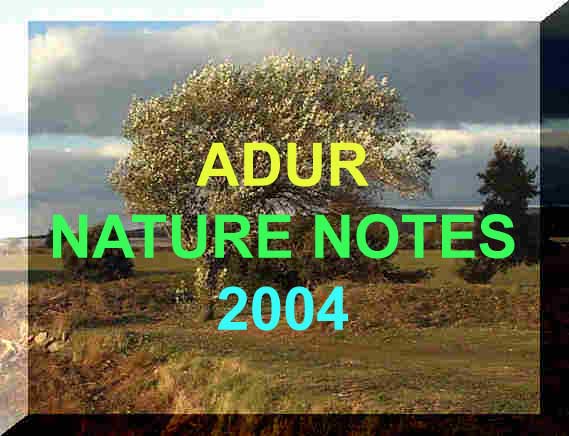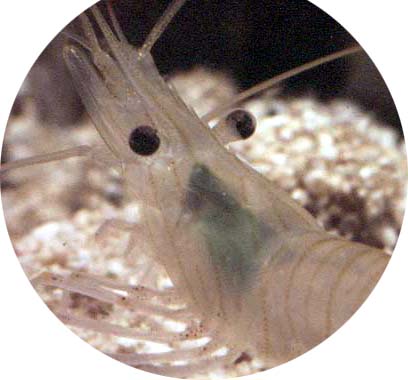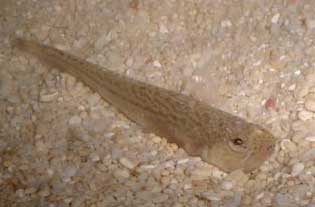 |
|
|
 |
|
(ADUR VALLEY & DOWNS) |
|
(WEBCAM) by Softwair Publishing |
|
Approx. Sea Temperature & Wave Heights |
|
|
Sussex:
The Sea
Undersea
& Bird Reports
Mostly
Offshore of the Adur District
Boar
Fish Capros aper
Photograph
by Andy Horton
WILDLIFE NEWS AND EVENTSLink to Marine Wildlife Reports off Sussex 2005
13 November 2004
A Pogge, or Armoured Bullhead, Agonus cataphractus, was photographed under Selsey Lifeboat Station at a depth of four metres in a sand and muddy area with a few areas of hard clay bedrock. The sea temperature was 11° C.
Report and Photograph by David Cropp
The Pogge (it is not clear how often this book name is used) or Armoured Bullhead or Hooknose, is a fish that is rarely reported by divers, anglers, fishermen, rockpoolers or shrimpers, but this absence is not because it is rare. It is believed to be common in the shallow seas over sand around most of the British coast and it is one of the small fish most often washed up dead on the strandline of Sussex. Its small size and favoured habitats means that its is not caught on rod and line and it inhabits the rather barren sea bed areas that are of little interest to divers. It swims over sand and its sensory organs around its mouth indicates it feeds on organisms in the sand, probably worms and shrimps. They is a complete absence in the BMLSS records of live specimens caught on the shore.
It should be confused with the often encountered Short-spined Bullhead (or Sea Scorpion), Taurulus bubalis.BMLSS Seahorse Page
30 October 2004
A Whiting was caught on rod and line four miles out of Brighton, Sussex, and it promptly regurgitated a Seahorse, Hippocampus sp. Seahorses are not known off the Sussex coasts, although I have received at least one unconfirmed sighting before.
Seahorse Trust
Seahorse Surveyc. 20 August 2004
Whilst night diving at Shoreham beach, West Sussex I found a bright banded orange and white prawn. It was spinning around probably to avoid my torch light. This appears to be one of the Prosseca species which are seen at night. They lack the pronounced rostrum of the abundant Palaemon species of prawn.
ImageReport by Paul Parsons (Sompting)Adur Intertidal8 August 2004
Four probable Bottle-nosed Dolphins, Tursiops truncatus, were seen one mile of Littlehampton, from a "Frenzy" ocean fishing kayak, occasionally breaching the surface for a second of the flat calm sea.Report by Chris Courderoy
A woman is stung by a Weever Fish, Echiichthys vipera, whilst bathing off Shoreham Beach.
Beware of the Weever
31 July 2004
The two Triggerfish, Balistes capriscus, we saw underneath the Palace Pier, Brighton, were of different sizes the larger being darker in colour and about 30 cm from tooth to tail. They both looked healthy and lively.Report by Paul Parsons (Sompting)
27 July 2004
Definitely two possibly three dolphins were spotted from the Sussex Sea Fisheries vessel "Watchful" outside the entrance of Brighton Marina swimming just below the surface breaking the water but not jumping. They were between 2.5 metres and 3 metres in length and were probably Bottle-nosed Dolphins.Report by Robert Clark (Sussex Sea Fisheries District Committee)BMLSS Cetacea (Whales & Dolphins)
11 July 2004
Shoreham Port Open Day
The Fish Festival display included a Triggerfish, Balistes capriscus, caught off Sussex the previous day, with a handful of other fish including Bass, two Stingrays, a Nursehound, Atlantic Eels, Corkwing Wrasse, Undulate Rays, one large Plaice and some invertebrate life with crustaceans that included Lobsters, Spider Crabs Maja squinado, Velvet Swimming Crabs, Common Hermit Crabs, Shore Crabs and molluscs including live Scallops.The Triggerfish (photographed above) swam around occasionally rising to the surface and expelling water from its mouth. It did not appear to be in discomfort and looked in a healthy condition.
At just after nine in the morning a single Peregrine Falcon flew around the Power Station Chimney and there were hundreds of Moon Jellyfish, Aurelia aurita, in the canal section of the harbour.
7 June 2004
A large dead whale was reported five miles south of Brighton, Sussex. No further details are known yet.Report by Robert Clark (Sussex Sea Fisheries District Committee)
5 June 2004
ADUR WORLD OCEANS DAY
Venue: Coronation Green, Shoreham-by-Sea
Adur was one of the leaders in the United Kingdom when it presented an Exhibition celebrating the official World Oceans Day. It was held in the large marquee on Coronation Green overlooking the River Adur.
I estimated the attendance on a sunny day (21.4° C) at 3,500 (estimates of attendances at other events have been overstated).
With the sheer number of people it made it impossible to speak to people as much as I would like. There were lots of interesting conversations and I was surprised about the number of people who stepped on a Weever Fish last summer, at least half a dozen, and it was lucky we had a small specimen on display so people could have a look at the offender.
The most interesting discovery was an unidentified fossil found on Shoreham beach and brought in by a young girl. This is illustrated on the right.
The fossil is part of a test (internal shell) of a sea urchin formed about 85 million years ago. The long spines have broken off leaving the base only. The exact species has not been established yet.
Adur World Oceans Day 2004 Image Portfolio (by Ray Hamblett)
3 June 2004
A short 30 minute spell of push-netting for shrimps off Shoreham beach on the low spring tide produced two dozen Brown Shrimps, Crangon crangon, a handful of the South-clawed Hermit Crab, Diogenes pugilator, one young venomous Lesser Weever, Echiichthys vipera, two juvenile Grey Swimming Crabs, Liocarcinus vernalis, with 30+ young Flounders and two young Sole. The crab in the photograph with the "fleur-de lis" is Portumnus latipes. (TQ 215 046)
Identification DiscussionsIdentification of the crab (left) by Guido Rappé (Belgium)Identification of the crab (right) by by Richard Lord (Guernsey)Adur at Low Tide
and others on the Marine Wildlife of the North-east Atlantic Ocean Group
British Marine Life Study SocietyMay 2004
A bloom of plankton, probably Phaeocystis pouchetti, has turned the River Adur almost orange and considerably reduced visibility in the enriched sea. The colonies of this flagellate organism Phaeocystis can be seen in the water at over 1 mm long and plankton will be continuous for miles of sea water. The sea is then by various local terms like Slobweed or Baccy Water because of its appearance. When the plankton dies it can create hypoxic conditions and generally the inshore fauna is diminished in quantity and variety.8 April 2004
Although small specks through the binoculars, three Great Crested Grebes now displayed distinctive crests as they were seen resting on the calm sea off the Church of the Good Shepherd, Shoreham Beach.
24 March 2004
There were at least three large grebes, on the surface and diving under the water off the coast of Shoreham and then off Lancing, by Widewater. The first diving bird was too far out and only its outline could be seen through binoculars. Further west at Lancing the two birds were much closer inshore and frequently diving under the sea and for at least 50% of the time they were under water. It was then the white neck could be clearly seen as well as the length of the beak. Unfortunately, I failed initially to make precise observations, but I am still confident that these three birds were Great Crested Grebes, in winter plumage but both birds seemed to have the beginnings of a rudimentary crest. This grebe is a regular winter visitor but this is the first time I have positively observed them.8 March 2004
The Lumpsucker, Cyclopterus lumpus, (large and rather strange looking inshore fish) was out in it's full colours off Selsey (West Sussex)! I had my lamp with me so we got a good look. His coloration was made up of yellow through to orange into cerise. He was in good shape, no scratches or damage and no visible lice, and no green or grey colours.
Image (Link)Report by Paul Parsons (Sompting)
Lumpsuckers breed off the Sussex coast. Occasionally adult fish are washed up dead on the shore and because of their unusual appearance, they attract curiosity. The larval fish are some of the first to be seen inshore from May onwards.
29 January 2004
A "skein" of dolphins were observed in the sea off Widewater Lagoon, Lancing, Sussex at 2:00 pm in the afternoon. This was an unusual event off the Sussex coast and most occasional observations have been in the summer months. Pods of dolphins have been seen off Selsey Bill, West Sussex in the last few days. "Skein" is the term used by the observer and I have not known this collective noun used before.Hearsay Report by Brian Street (Shoreham)British Marine Life Study Society News Reports Winter 2004
Adur Valley Nature Notes (January 2004)
BMLSS Cetacea
- REPORTS
UP TO 2003 (LINK)
31
May 2003
Shoreham
bathed in a heat wave up to
24°
C for the opening of the Adur Festival and
Adur
World Oceans Day 2003 on Coronation
Green, Shoreham-by-Sea. About
3000 people attended the event that was steady and busy throughout.
Exhibits
included live fish and lobster in aquaria, colouring and badge-making,
whales
and dolphins, birds, shrimps, fish-tasting, touch-table, Shoreham shingle
beach flora and undersea colour photographs and videos.
A special thanks to all the participants, especially Len Nevell (British Marine Life Study Society) and Steve Trewhella (Marine Conservation Society). The inflated dolphin was provided by Steve Savage (Sea Watch Foundation).
Several groups had special exhibitions including the:
British
Marine Life Study Society including Shorewatch
(four exhibits)
West
Sussex County Council Countryside Unit
Sea
Watch Foundation (for Whales & Dolphins)
Sussex
Sea Fisheries District Committee
SeaSearch
(Undersea Biological Recording)
Shoreham
& District Ornithological Society
Sussex
Ornithological Society
Adur
World
Oceans Day 2003
10:00
am - 4:00 pm
Popular
Information File on Adur World Oceans Day
2003
Acrobat
Information File on Adur World Oceans Day
2003

MARINE WILDLIFE OF THE NORTH-EAST ATLANTIC OCEAN (LINK TO EFORUM PAGE) |
LINK
FOR MORE INFORMATION ON JOINING THE EFORUM
(CLICK
ON THIS TEXT)
Local Wildlife Links (SE England)
Adur
& the Downs: Protected Sites
Adur
Valley Nature Notes
Adur
Valley Wildlife
Adur
Valley Wildlife Gallery
Dolphins
off Sussex
Dungeness,
Kent, England
Lancing
Ring
Orford
Ness: Coastal Ecology of a Shingle Bank (excellent references)
Ralph
Hollins Nature Pages (Chichester Harbour area)
Rye
Harbour Nature Reserve
Rockpooling
Page
Seashore
Page
Shingle
Coast (Coastal Fringe of Shoreham Beach)
Shoreham-by-Sea
Wildlife Page
Tides
Unusual
Sussex Fish Discoveries
Worthing
Pier (Undersea world underneath the pier)
|
|
|
|
|
Copyright © Andy Horton 1997-2002










